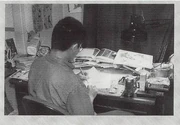Kentaro Miura.
Kentaro Miura was born in Chiba, Japan on the 11th of July 1966.
In 1976, in primary school and being only ten years of age, Miura was already working on a manga. This first work titled "Miuranger" was said to be made for his class mates, and appeared in some of the school’s publications and books. As time progressed, "Miuranger" ended up finishing at around 40 volumes. A year later, Miura was working on his next work entitled "Ken e No Michi" or "The Way Of The Sword" - his first work drawn using Indian ink. By 1979 and in middle school, Miura had began using rasters for his work, and had oriented himself to use professional drawing methods.
In 1982 he enrolled in an artistic curriculum in high school, where together with his friends and class mates they had their work published in school booklets, as well as having his first dojinshi published in a fan produced magazine.
Busy times for Mr. Miura in 1985. Miura applied for, and was accepted into an art course at the Niho Daigaku University. Two more works are started this year also, "Futanabi" and "Noa" - which may have been the work he showed to gain entry to the University in the first place. "Futanabi" and "Noa" where also submitted to the Shonen magazine, the magazine awarding Miura a prize for the best new author for "Futanabi", and they actually published "Noa" in their magazine towards the end of that year. However the publications were short lived; Miura had a difference of opinion with one of, or the editor, and no further work was published. This apparently starts some hard times for Mr. Miura.
With 1988 came the first appearance of his "Berserk". The 48 page manga - which we know today as the "Berserk Prototype", it was sort of a preview of things to come, but not quite the Berserk we know and love today. Still, it wins Miura a prize from the Comi Manga School and things start to look up.

Miura at work.
Having finished his course, receiving a doctorate, in 1989 sees yet another work, entitle "Ohroh" or "The Wolf King" which is based on a script written by Yoshiyuki "Buronson" Okamura, creator of "Hokuto no Ken", of Fist of the North Star fame. "Ohroh" is published in the monthly Japanese Animal House magazine, in issues 5 and 7 for that year. The 10th issue of Animal House that year saw the first ever, and only publication for that year of Miura's solo work "Berserk". The year ending with "Ohroh" being released as a stand alone manga volume.
From the 2nd to the 6th issues of Animal House in 1990, a follow up to "Ohroh" is published. Entitled "Ohrohden" or "The Legend of the Wolf King", it too is based on a script by Okamura. "Ohrohden" receives a stand alone volume release that same year, but more importantly the first volume of what we know today as "Berserk" was released, though it only enjoyed limited success. It isn’t until a whole year later, with the release of the story arc entitled "The Golden Age" did "Berserk" find a degree of popularity and success.
Yet another joint effort between Miura and Okamura in the 1992 work "Japan", appearing in issues 1 through to 8 of Animal House for that year, again with stand alone manga volumes following later in the year. The year ends with "Berserk", currently only being released in volumes, again being taken up, but this time by the Japanese magazine Young Animal where it has enjoyed serialization ever since. That year, Miura decides to dedicate himself solely to working on "Berserk".
1997 saw the release of various art books and supplements by Miura based on "Berserk" as well as Miura overseeing the production of a 25 episode animated series based on his "Berserk" to be aired on Nihon TV in Japan. Since then in more recent times, the manga has made its way to 26 released volumes, 27 just around the corner and it is still going strong and with no end in sight, as well as having picked up a cultural award, second place supposedly, for Miura in 2002 earning him one million yen. The series has also spawned a whole host of merchandise, both official and fan made, ranging from statues, actions figures to key rings, video games, and a trading card game.
Both the manga and the anime have had success outside Japan, with both already available throughout Europe having been translated into various other languages from its original Japanese. America has just been privy to the release of the anime resulting in a push for more to be created, and possibly indirectly bringing about an official English release of the manga, the first three volumes available for purchase in the States as of now.
In 2013 Miura began work on a short 6 chapter mini series known as Gigantomakhia.
